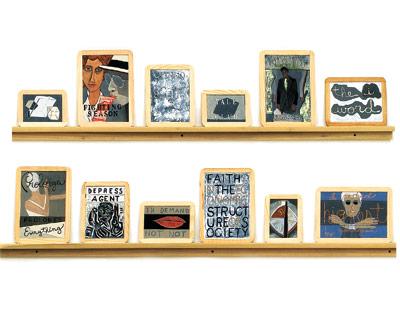Rafael Ferrer, an Artist Astride Two Worlds

As with others who have chosen the East End as an artistic retreat, Rafael Ferrer, 78, who lives in Greenport, made his way here in a circuitous route, one that reflected his own journey in making art.
Beginning on Saturday, Guild Hall will present “Contrabando,” an exhibit that started out as an abridged version of a much larger show at El Museo del Barrio in New York last year and ended up being something else entirely.
Esperanza Leon, who acted as guest curator for the exhibit, said she had previously worked with Museo del Barrio and had wanted to work with a Latin American artist. Although Mr. Ferrer said that as a Puerto Rican-born artist he is not technically a Latino, he is quoted in the show’s catalog as saying his art has “an accent, one influenced by a Latin temperament.”
Mr. Ferrer wrote in an e-mail message that a “Puerto Rican cannot be a Hispanic or a Latino because Puerto Rico is not a sovereign country. Puerto Rico is owned by the United States and remains the oldest colony in the world. So the short answer is that I began and remain an individual artist.”
He added, “I first registered in the New York art scene in the 1960s, before ethnicity was introduced. Curiously, my coming-out moment involved ice, leaves, hay, and grease.” He was associated early on with process art, and one of the early conceptual pieces that he exhibited with artists such as Robert Morris and Richard Serra used those materials.
“My peers were English speaking and American born. Ethnicity was born with the social upheavals of the 1960s-1970s. Hispanics and Latinos, i.e., individuals from any of the South or Central American republics, joined African-Americans, women, and gay, lesbian, and transgender minorities in the struggle for equal rights and respect.”
Mr. Ferrer attended Syracuse University for two years before studying at the University of Puerto Rico. During the summers while he was in school he spent time in California with José Ferrer, his much older half brother, who was a film actor married to Rosemary Clooney, and in Paris, where he met surrealists such as Andre Breton and Wilfredo Lam.
He said that José, who was born in 1912, studied in Switzerland and graduated from Princeton University, where his acting career began and “subtle Waspy racism was perceived but never made an issue of. That was not his nature.”
For Mr. Ferrer and his artistic reputation, returning to painting was far more radical than any question of ethnicity. He did so in the early 1970s, which is when the Guild Hall show begins, taking us up to his current works.
“This is a unique show for Guild Hall,” Ms. Leon said last week, “nothing to do with the El Museo del Barrio” one, which was a full retrospective. Because the art establishment was more interested in his earlier work, the New York City show “was a revelation for most people.” It focused on paintings rather than conceptual pieces, which were documented mostly with photographs.
The focus at Guild Hall is “on paintings and the enormous diversity of objects.” Some 50 pieces make up the installation, which will be shown in just one gallery, the others showing work by Drew Shiflett and pieces from the permanent collection.
“The Guild Hall exhibit allows us to show different examples of works that hopefully add in the understanding of the various trajectories,” Mr. Ferrer said. “In a sense it has an intimacy not as clearly seen at El Museo.”
There will be several smaller pieces and a few monumental paintings, as well as small sculptures, a collection of individual paper bag works (typically faces ranging in style from primitive to early modern), and a large new installation of the artist’s blackboard pieces, which have to do with language.
Ms. Leon said she found that the importance of language was key to Mr. Ferrer’s work. “He emphasizes a great deal that he is bilingual in Spanish and English.” Working on the catalog, which is also bilingual, it became “interesting how things translate. ‘Contrabando,’ the title, that’s him playing between two places of language and culture elements, the official sphere of art and contemporary art. He’s always working on the margin somewhere, just outside that center of the art world.” He is not an artist who can be pigeonholed, and he’s comfortable with that, she added.
The exhibit will open with the other shows at Guild Hall on Saturday with a reception from 6:30 to 8:30 p.m.
On Nov. 12 at 3 p.m., Mr. Ferrer will speak with Barry Schwabsky, the art critic of The Nation. On Dec. 10 at 3:30 p.m., Edward J. Sullivan, a professor of art history at the Institute of Fine Arts and New York University, will also examine Mr. Ferrer’s work with the artist in attendance. The talks are free with museum admission.
